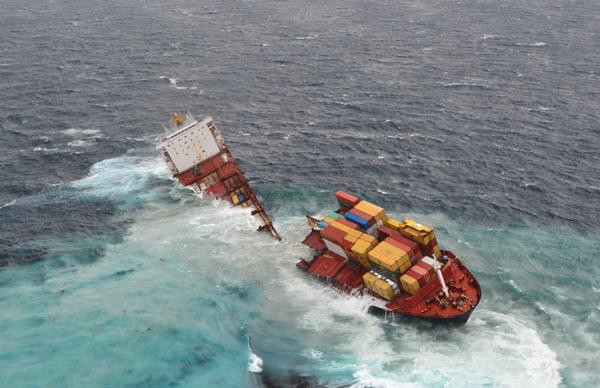Rena update (update 148)

8 January 2012 - 7PM
Communities along the Bay of Plenty coastline are being advised that container debris and oil from the wreck of the MV Rena is likely to begin coming ashore overnight and tomorrow, with a coordinated response ready to deal with whatever washes up, Maritime New Zealand (MNZ) says.
MNZ Salvage Unit Manager David Billington said while both sections of the Rena were still on the Astrolabe Reef, the stern section had moved an estimated 30m from the bow section in seas of over 7m overnight, after the stern pivoted about 13 degrees to starboard.
“While the two sections remain on the reef, both are now open to the sea and vulnerable to more damage. The stern section is also listing heavily at about 24 degrees and is heaving in current swells of about 4.5m. The bow section is still firmly wedged in place on the reef, but it is open to flooding from the sea and is expected to deteriorate further in the rough conditions.”
MNZ Salvage Advisor Jon Walker said that there was a strong likelihood that the stern section would capsize and sink, which would make recovering any further containers from that section considerably more difficult.
Container recovery company Braemar Howells estimate that between 200 and 300 containers of the approximately 830 remaining on the Rena were lost overboard when the two sections of the ship separated, of which 30 had been identified, with 17 tagged with buoys. However due to poor visibility and the rough conditions around the Rena, it was difficult to gain a more accurate count.
Acting Operations Manager Claudene Sharp said that between 40 and 60 of the lost containers would likely be floating while the rest will have sunk. Those which had already been located would be collected when the sea state improved. A vessel equipped with sonar was searching for other containers, and the priority was to ensure that the shipping lanes remained clear. Several different vessels, including tugs, barges and landing craft, were also available to recover the containers and debris as soon as conditions allowed.
Ms Sharp said current weather patterns were pushing containers in a westerly direction between Astrolabe Reef and Mayor Island, and warned that debris or damaged containers could come ashore along the Bay of Plenty coastline over the next 12-24 hours.
National On Scene Commander Alex van Wijngaarden said that the National Response Team had been mobilised to deal with any fresh oil released from the ship, and members of the National Oiled Wildlife Response team would be checking Mount Maunganui and Leisure Island for oiled birds overnight. Assets from the Royal New Zealand Navy would be used to help patrol the exclusion zone around Rena and help ensure harbour channels remained clear, he said.
Mr van Wijngaarden said it was very unlikely that oil reported ashore today was from last night’s break-up of the Rena because wind and tides had initially taken it off-shore, and was thought to be old oil that had been remobilised due to the recent rough weather.
“Any oil coming ashore in the coming days is expected to be much less the amount that washed up after the Rena first went aground.
“Current modelling suggests that beaches south east of Mt Maunganui are most likely to be affected by oil and debris, which includes milk powder and timber. Anyone finding oil or debris is asked to report it immediately to 0800 645 774 and to stay well clear, as all debris must be treated as if it is contaminated.
Mr van Wijngaarden said no Tauranga beaches had been closed, but local surf life savers today advised people to stay out of the water because of the debris and sea conditions.
“We reiterate the message that people need to exercise their common sense and not swim or surf where there is likely to be containers, debris or oil coming ashore. Also we ask that people keep clear of any debris or oil, and report it to us so that our trained people can come and clean it up.”
Wind and sea conditions were constantly being modelled to plot the trajectory of oil and debris. There is no way of knowing exactly how much oil was released from the duct keel when Rena’s bow and stern separated, but some could still be trapped in the stern section.
Meanwhile, navigational warnings have been issued to shipping, with the port company communicating with individual ships via port radio and warnings issued to recreational vessels via Coastguard radio. Shipping lanes were also being monitored for containers and debris and the 3 nautical mile exclusion zone around the Rena remains in place, along with a 1500 feet no-fly zone.
At today’s press conference in Tauranga, Environment Minister Nick Smith said that the efforts of MNZ and the salvors over the last three months ensured that the impact of the Rena’s break-up was much less than would have been the case when the vessel first went aground. “The risk to the environment is a fragment of what it was, with at the most tens of tonnes of oil rather than hundreds of tonnes that potentially could be spilled.”
He said that the environmental risk from dangerous goods known to be on board Rena was small. There were originally 21 containers of cryolite from the Bluff aluminium smelter and many containers of milk powder. Both these substances would be well diluted by sea water, Mr Smith said.
The current bad weather is forecast to slowly ease over next 3 – 4 days, though seas are expected to remain rough with 4 – 4.5m swells.
